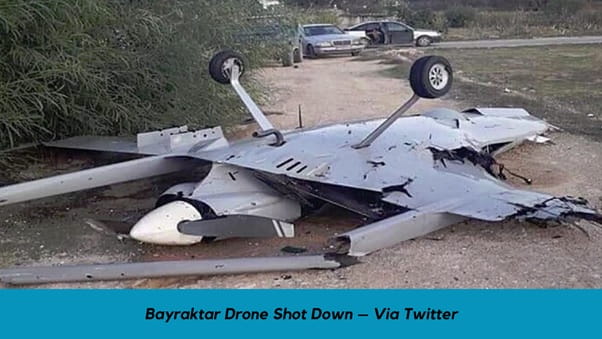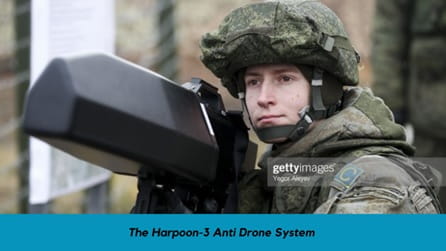In previous articles, you may have gained an understanding of how counter drone systems work, including various techniques for detection and jamming, such as visual detection, radio frequency detection, radar detection, and multi-sensor configurations, as well as soft-kill jamming methods and hard-kill methods Now, we will take a closer look at the utilization of counter drone systems in the Russia-Ukraine conflict and analyze the impact this conflict has had on the development of drone versus counter-drone warfare technology.
The Armenia-Azerbaijan conflict heralded the arrival of Drones on the modern day battlefield, with Armenia acknowledging that the Turkish Bayrakter TB-2 had made the difference forcing them to concede defeat. The Bayraktar TB2, developed and manufactured by Baykar, a Turkish defense company, is the size of a small airplane and equipped with four laser-guided missiles. It has an endurance of 12 hours when operating 550 nautical miles from its base. This gives it the ability to be ‘eyes in the sky’ for long periods of time.
 From the Indian viewpoint, Turkey has been off late hostile to India and Pakistan has also acquired Bayrakter TB-2 drones. Indeed, Baykar is known to have a manufacturing facility in Pakistan. Commercial drones manufactured by DJI such as Mavic 3 and Phantom 4 have also been extensively used by Pakistan in Punjab to transport contraband and even grenades and light rifles. It would be therefore be instructive to study Russian efforts to counter the drone threat from Ukraine.
From the Indian viewpoint, Turkey has been off late hostile to India and Pakistan has also acquired Bayrakter TB-2 drones. Indeed, Baykar is known to have a manufacturing facility in Pakistan. Commercial drones manufactured by DJI such as Mavic 3 and Phantom 4 have also been extensively used by Pakistan in Punjab to transport contraband and even grenades and light rifles. It would be therefore be instructive to study Russian efforts to counter the drone threat from Ukraine.
In the early days of the Russia-Ukraine conflict, the TB-2 had been very effective in stemming the advance of the Russian Army to Kyiv. This was also largely on account of the Russian tanks’ inability to go off the road and advance cross country. The spring thaw meant that the countryside had become slushy and the tanks got bogged down in the melting snow. They were thus sitting ducks and could be picked off relatively easily by the TB-2 drones. Arguably, they had greater value as a means of reconnaissance since impending Russian movements could be detected and responses formulated to stymie the advance.
In addition both sides are known to have used the Mavic 3 drone manufactured by the Chinese company DJI since these drones are commercially available off-the-shelf. Their small size makes them difficult to detect and are very effective in reconnaissance and carrying small payloads of up to a few kgs.
Russia leveraged its experience in Syria and Libya to evolve an effective counter drone strategy. The Syrian experience of defending the Khmeim air base from the incessant drone attacks by anti-Assad groups, led to counter-UAV training being provided to all arms, trades, and services of the Russian military as early as 2018. Considering the all-pervading ubiquitous nature of the threat, not only infantry units but also tanks, artillery crews, logistics, signallers, scouts, maintenance specialists, and even cooks were trained to shoot at quadcopters.
Meanwhile, private, state-run Russian companies and research institutes began developing highly effective anti-drone electronic warfare systems, for jamming the drones’ Remote Control links, and Global Navigation Satellite Signals (GNSS).
The Special Technology Center LLC in Moscow developed the Stiletto, a short-range man-portable backpack containing a hybrid gun-EW anti-drone system. Zala Aero (part of Kalashnikov Concern) had developed the REX non-lethal gun in late 2017 that could jam geolocation signals from the American Global Positioning System (GPS), Russian GLONASS, China’s BeiDou, and European Galileo within a 5 km radius.
The ‘Repellant’ electronic warfare complex was designed especially to tackle drone swarms. Made by the Scientific and Technical Center for Electronic Warfare in Moscow, the system with a range of 30 km is mounted on a Kamaz truck. Its lightweight version is the ‘Silk’ stationary system, which protected Russian stadiums in the 2018 FIFA World Cup.
In Yemen, relentless attacks by the Houthis by Iranian-made drones against Saudi Arabian forces exposed the vulnerability of robust air defence systems like the Patriot. This emboldened Russia to acquire Shahed -136 drones from Iran significantly bolstering its ability to carry out deep strikes against Ukrainian infrastructure especially power stations. The earlier version had an Inertial Navigation System which while possessing the ability to stay undetected by Radio Frequency Drone Detectors was not accurate enough. It has since been integrated with GLONASS, the Russian Satellite Navigation System significantly increasing its precision. All this has also meant that it has been able to preserve its indigenous drone, the ORLAN-10 which has an operating range of roughly 110 kms or so. This is significantly lesser than the Shahed-136 drone which has a range of 1600 to 2000 kms.
After its earlier reverses, Russia employed a layered air defence system to protect its strategic assets in the rear. The S-400 and the S-200VE Vega, perhaps, provide the long-range defence, with the medium-range defence is provided by the S-300FM ‘Fort’ and Buk-M2E. Short-range quick reaction defence is likely to be undertaken by the Osa-AKM and the S-125 Pechora. The Pantsir-S1 protects the S-400 themselves. After August 2022, there is no denying that the TB-2 has lost its dominance of the battlefield. Shooting down of the TB-2 and equipment forensics has helped the Russians in determining the communication protocols of these drones. Therefore, the seamless integration of hard kill and soft kill EW systems as part of the layered defence has bolstered the effectiveness of their Air Defence Systems.

As far as the front lines are concerned the real threat was from the commercial drones and it is likely that Jamming Rifles have been provided to the front-line troops. Reports suggest that the Harpoon-3 developed by the Automation and Programming Technologies Company based in St. Petersburg, and unveiled at the MAKS-2021 air show in Moscow last year is now deployed.  The anti-drone gun mounted on a special platform with guidance drives in two planes and remote control, allows one operator to control several anti-drone guns dispersed over a particular area simultaneously. The device is trained toward a target visually and within line of sight, after which the trigger is pulled to release an electromagnetic pulse in the direction of the target to disrupt the communication between the drone and its operators. The device has an operational range of 3 – 5 km. With a frequency range between 433 to 5800 MHz, it has the ability to disrupt the Remote Control link, the GNSS links and the telemetry link.
The anti-drone gun mounted on a special platform with guidance drives in two planes and remote control, allows one operator to control several anti-drone guns dispersed over a particular area simultaneously. The device is trained toward a target visually and within line of sight, after which the trigger is pulled to release an electromagnetic pulse in the direction of the target to disrupt the communication between the drone and its operators. The device has an operational range of 3 – 5 km. With a frequency range between 433 to 5800 MHz, it has the ability to disrupt the Remote Control link, the GNSS links and the telemetry link.
Apart from Harpoon-3, Russian forces are also using the Stupor electromagnetic system, developed by the Main Robotics Research and Test Center of the Russian Defense Ministry. It has an operational range of 2 km and a 20-degree field of effect.

Ukraine is also known to have deployed the Lithuanian SkyWiper EDM4S (Electronic Drone Mitigation System) counter-drone rifle with a range of 3-5 kms. Fitted with four antennas, and a 10W Power Amplifier it can effectively counter commercial drones. However, Ukraine apparently has no answer yet for the Shahed-136 drones that are creating havoc in its cities.
Finally, as always geopolitics has probably had a role to play in the vanishing of the TB-2. Reportedly, Turkey backed out from establishing a Baykar manufacturing plant in Ukraine, and has indeed stopped supplying new drones when Russia used its energy deal as a weapon.
Fools as they say learn from their experiences. The wise learn from the experiences of others. India would be well advised to do the same.